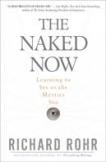Corrected Vision
Maybe 45 years ago I read a book that introduced me to the importance of contemplative prayer and mysticism. It was Thomas Merton’s autobiography, The Seven Storey Mountain. In a striking passage, the young Merton is moved by the prayer and peacefulness of a student from India, a monk whom he calls Bramachari. When Merton wants to become a Hindu, Bramachari suggests he should discover his own Christian mystical heritage instead. That book, it is fair to say, had a life-changing effect upon me.
Today, Richard Rohr is regarded by many as one of the most effective writers and teachers connecting modern and postmodern readers with their heritage and with the blessings of contemplation. A Franciscan priest, he founded the Center for Action and Contemplation. His book Everything Belongs, which describes one of the essential insights of the mystical life, the union or harmony of all things, has become a classic. Rohr’s new book, The Naked Now: Learning to See as the Mystics See, has a similar objective but is more wide-ranging. Again, it promises to the dedicated contemplative a new dimension of existence, a more peaceful life, a deeper way of seeing.
Yet the book seems to glide, rather than build. It offers a series of linked essays, each worthwhile in itself, but not precisely gathering into a dynamic argument. And it does not seem to have a beginning, middle and end. It delves and explores. It moves along a kind of spiritual continuum, consistent with the author’s insight that contemplative living will calm our anxieties and keep us on the flat, slowing our pace and transforming our existence day by day. The Naked Now is not about getting somewhere, constructing arguments, winning points. Instead it is about being on the way.
There are jewels in all this. One small section deals with the idea that prayer is resonance. Rohr explains that the word prayer has been “deadened by pious use and misuse. I am going to introduce a different word here, so you can perceive prayer in a fresh new way, and perhaps appreciate what we mean by contemplation.” By using “resonance,” Rohr compares prayer to “setting out a tuning fork.” Citing Mt 7:7, he insists that the Sender is always broadcasting. But we ourselves must tune in to receive this ongoing message. A bit later, Rohr reinforces the idea that we offer ourselves “nakedly.” He is sparing with his erotic language (very common with most of the mystics), but it is certainly there.
I suggest that the book not be read straight through, but rather in short increments, as one might read a book of meditations. Chapter headings offer many intriguing propositions. Here are a few: “The Great Unsaying,” “Three Ways to View the Sunset,” “The Meaning of Spiritual Love,” “Sinners, Mystics and Astrophysicists: How to Celebrate Paradox.” Each chapter offers a simple, self-contained exploration of the topic, learning to see as the mystics see.
Then, for those who are serious about practicing the contemplative life, there are eight appendices, which include: “Training for the ‘Third Eye,’” “Christian Tantra: the Welling Up Exercise,” “The Virgin Prayer,” and “The Walking Meditation: the Mirror Medallion.”
It is interesting that the title of Rohr’s book closely parallels the title of Eckhart Tolle’s book The Power of Now. I hope this parallel is a good thing, one that might lead Tolle’s readers to discover the deeper Christian tradition that undergirds promises made by the popular secular culture of meditation and transformation. Rohr’s book makes it obvious how the traditions of Christian prayer life stem directly from Jesus’ teaching. He also illuminates some of the Christian mysteries—like the real presence of Jesus Christ in the Blessed Sacrament—that underlie the Christian mystical tradition.
I am happy to say that Richard Rohr makes no claims to have invented what he is teaching. He quotes from the writings of some great teachers of the past, among them John of the Cross, Jean Pierre de Caussade, Brother Lawrence of the Resurrection and Francisco de Osuna, who influenced Teresa of Avila, and some mystical poets, including Gerard Manley Hopkins.
This work is not an argument about doctrine or psychology. Though Rohr expresses frequent concern about “dualistic thinking,” his concern lies in the realm of experience and self-understanding. At one point in the book he is careful to profess himself a sincere and believing Catholic, against those who would assume otherwise from his currency in the contemporary world. But he wants to make the mystical life a possibility for the likes of you and me.
This article also appeared in print, under the headline “Corrected Vision,” in the February 15, 2010, issue.








